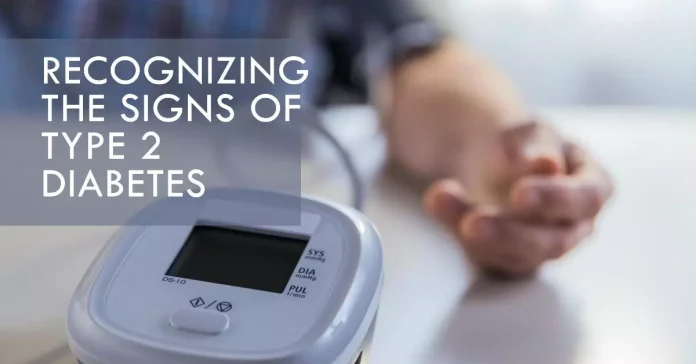Discovering the early signs of Type 2 diabetes is essential for taking proactive steps toward timely intervention and effective management. This comprehensive guide aims to teach you about crucial indicators, risk factors, and actionable strategies to maintain optimal health. Understanding the subtle signs and making informed lifestyle choices allows you to contribute to your well-being actively.
Section 1: Unmasking the Signs
Recognizing Subtle Symptoms
• Increased Thirst: One of the early signs of Type 2 diabetes is persistent thirst. It could indicate if you frequently reach for water throughout the day.
• Frequent Urination: Excessive urination, especially during the night, might signal the onset of diabetes. Pay attention to any changes in your bathroom habits.Understanding Blood Sugar Levels
• Role of Blood Sugar: Blood sugar, or glucose, is crucial to your body’s energy supply. Learn how fluctuations in blood sugar levels can serve as an early warning sign for Type 2 diabetes.
• Monitoring and Testing: Regular monitoring and understanding how to interpret blood sugar test results are essential for early detection. Discover the significance of fasting blood sugar and HbA1c tests.
Section 2: Risk Factors and Prevention
Genetic Predispositions
• Family History: Explore how a family history of diabetes can increase your risk and the significance of understanding your genetic predisposition.
• Genetic Markers: Learn about specific genetic markers associated with Type 2 diabetes and how advancements in genetic testing can provide valuable insights.The Impact of Sedentary Lifestyle
Sedentary Behavior and Diabetes Risk: Investigate the link between prolonged periods of sitting and an increased likelihood of developing Type 2 diabetes.
Practical Tips for Incorporating Movement: Discover simple yet effective strategies for incorporating physical activity into your daily routine, even if you have a desk-bound job.
Section 3: Navigating Nutrition
The Role of Diet in Diabetes Prevention
• Balanced Diet Basics: Explore the fundamentals of a balanced diet that supports overall health and helps prevent the onset of Type 2 diabetes.
• Importance of Fiber: Understand how incorporating fiber-rich foods can improve blood sugar control and overall digestive health.Sugar and Beyond
• Beyond Sweetness: Delve into the impact of added sugars and overall carbohydrate intake on blood sugar levels.
• Fats and Proteins: Understand the role of fats and proteins in a diabetes-friendly diet and how they contribute to sustained energy levels.
Section 4: Holistic Approaches to Management
Empowering Your Mind
• Stress Management: Explore the intricate connection between stress and blood sugar levels. Learn effective stress management techniques like mindfulness, meditation, and deep breathing exercises.
• Mental Well-being: Recognize the importance of maintaining positive mental health in diabetes management. Addressing anxiety and depression can positively impact overall well-being.Exercise as Medicine
• The Role of Physical Activity: Understand how regular exercise can aid in blood sugar control and improve insulin sensitivity. Discover the types and durations of exercises that are most beneficial.
• Creating a Sustainable Routine: Explore practical tips for incorporating exercise into your daily life, considering individual preferences and fitness levels.
Key Takeaways
- Early Detection is empowering: Recognizing the signs of Type 2 diabetes early empowers you to take control of your health. Timely intervention can make a significant difference in effectively managing the condition.
- Lifestyle Matters: Your lifestyle is pivotal in diabetes prevention and management. From making mindful dietary choices to embracing regular physical activity, each decision contributes to your overall well-being.
- Holistic Approach: Diabetes management is not just about monitoring blood sugar levels; it’s about adopting a holistic approach. Prioritize your mental well-being, manage stress, and make exercise an integral part of your routine.
Next Steps
Now armed with knowledge, it’s time to take proactive steps toward a healthier future. If you identify with any of the discussed signs or risk factors, consider the following:
- Consult with a Healthcare Professional: Schedule a check-up with your healthcare provider to discuss any concerns or symptoms you may have noticed. Early detection allows for prompt intervention and management.
- Embrace a Healthier Lifestyle: Incorporate the principles of a balanced diet, mindful eating, and regular physical activity into your daily life. Small, sustainable changes can have a profound impact on your overall health.
- Stay Informed: Continue educating yourself about Type 2 diabetes and wellness. Regularly check in with healthcare professionals, read reputable sources, and stay connected with support networks.
Conclusion
We’ve navigated the intricate landscape of Type 2 diabetes, exploring the early signs, risk factors, and proactive measures for prevention and management. Recognizing subtle symptoms, understanding blood sugar levels, unraveling genetic predispositions, and addressing lifestyle factors have provided valuable insights into this condition’s multifaceted nature.










